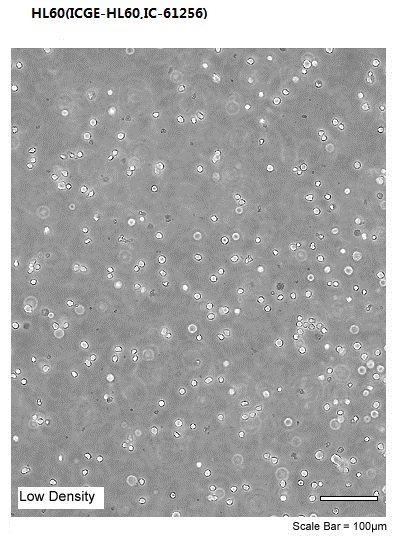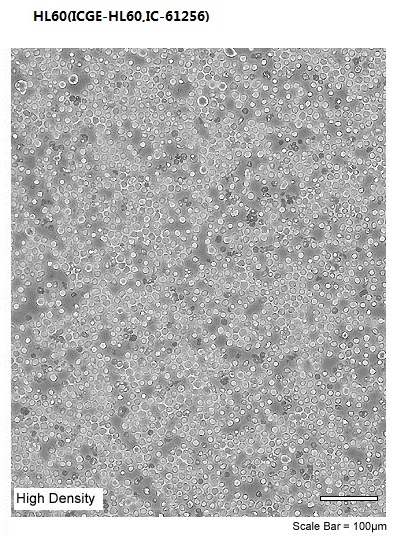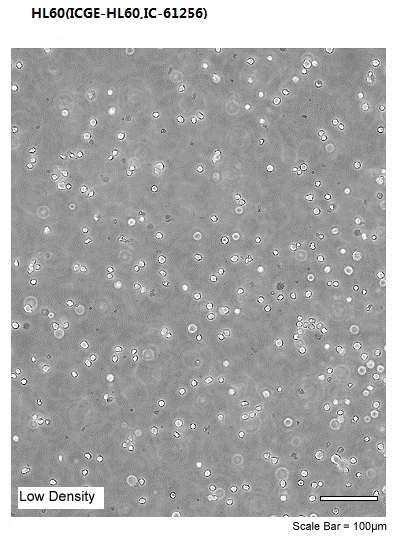


Overview
| Organism | Homo sapiens, human |
|---|---|
| Tissue | peripheral blood |
| Cell Type | promyeloblast |
| Product Format | frozen |
| Morphology | myeloblastic |
| Culture Properties | suspension |
| Biosafety Level |
1
Biosafety classification is based on U.S. Public Health Service Guidelines, it is the responsibility of the customer to ensure that their facilities comply with biosafety regulations for their own country. |
| Disease | acute promyelocytic leukemia |
| Age | 36 years |
| Gender | female |
| Ethnicity | Caucasian |
| Applications |
This cell line is a suitable transfection host.
|
| Storage Conditions | liquid nitrogen vapor phase |
Properties
| Karyotype | The stemline chromosome number is pseudodiploid with the 2S component occurring at 6.2%. Five markers (M2 through M6) were common to most S metaphases. DM''''''''s, which varied in numbers per cell, occurred in all metaphases karyotyped. HSR chromosomes were not detected. |
|---|---|
|
|
|
| Derivation |
HL-60 is a promyelocytic cell line derived by S.J. Collins, et al. Peripheral blood leukocytes were obtained by leukopheresis from a 36-year-old Caucasian female with acute promyelocytic leukemia.
|
| Clinical Data |
36 years
Caucasian
female
|
| Receptor Expression |
complement, expressed
Fc, expressed
|
| Oncogene | myc + |
| Genes Expressed |
tumor necrosis factor (TNF), also known as tumor necrosis factor alpha (TNF-alpha, TNF alpha), after stimulation with phorbol myristic acid,myc +
|
| Cellular Products |
tumor necrosis factor (TNF), also known as tumor necrosis factor alpha (TNF-alpha, TNF alpha), after stimulation with phorbol myristic acid
|
| Tumorigenic | Yes |
| Effects |
Yes, in nude mice (subcutaneous myeloid tumors)
Yes, in semi-solid media
|
| Comments |
HL-60 cells spontaneously differentiate and differentiation can be stimulated by butyrate, hypoxanthine, phorbol myristic acid (PMA, TPA), dimethylsulfoxide (DMSO, 1% to 1.5%), actinomycin D, and retinoic acid.
The cells exhibit phagocytic activity and responsiveness to chemotactic stimuli.
The line is positive for myc oncogene
|
Background
| Complete Growth Medium |
The base medium for this cell line is ATCC-formulated Iscove''''''''s Modified Dulbecco''''''''s Medium, Catalog No. 30-2005. To make the complete growth medium, add the following components to the base medium: fetal bovine serum to a final concentration of 20%. |
|---|---|
| Subculturing |
Cultures can be maintained by the addition of fresh medium or replacement of medium. Alternatively, cultures can be established by centrifugation with subsequent resuspension at 1 X 105 viable cells/mL. Do not allow cell concentration to exceed 1 X 106 cells/mL. Corning® T-75 flasks (catalog #431464) are recommended for subculturing this product.
Interval: Maintain cell density between 1 x 105 and 1 x 106viable cells/mL.
Medium Renewal: Every 2 to 3 days
|
| Cryopreservation |
Freeze medium: Complete growth medium supplemented with 5% (v/v) DMSO
Storage temperature: liquid nitrogen vapor phase
|
| Culture Conditions |
Atmosphere: air, 95%; carbon dioxide (CO2), 5%
Temperature: 37��C
|


